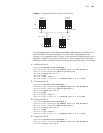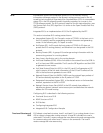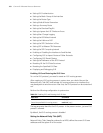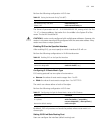106 CHAPTER 5: IP ROUTING PROTOCOL OPERATION
All the Level-2 routers make up the backbone network of the RD, which is
responsible for the inter-area communications. Every area has at least one router
located on both Level-1 and Level-2 (called a Level-1/Level-2 router), which
connects the area to the backbone network. A Level-1/Level-2 router contiguous
with a router in some other area will notify the Level-1 routers in the local area
that it is an exit point from the area.
For an NPDU to go from its own area to another area, a Level-1 router will first
transmit it to the nearest Level-1/Level-2 router in the local area, regardless of its
actual destination area. Then, the NPDU will be transmitted over the Level-2
backbone network to a Level-1 router in the destination area. Finally the Level-1
router transmits the NPDU to the destination.
Figure 9 illustrates a network running the IS-IS routing protocol and composed of
two RDs, Routing Domain 1 and Routing Domain 2. Routing Domain 1 includes
two areas, Area 1 and Area 2, and Routing Domain 2 only has Area 3. In Routing
Domain 1, the three ISs connected by bold lines compose the area backbone. They
are all Level-1/Level-2 routers. The other 4 ISs not connected by bold line are
Level-1 routers.


















